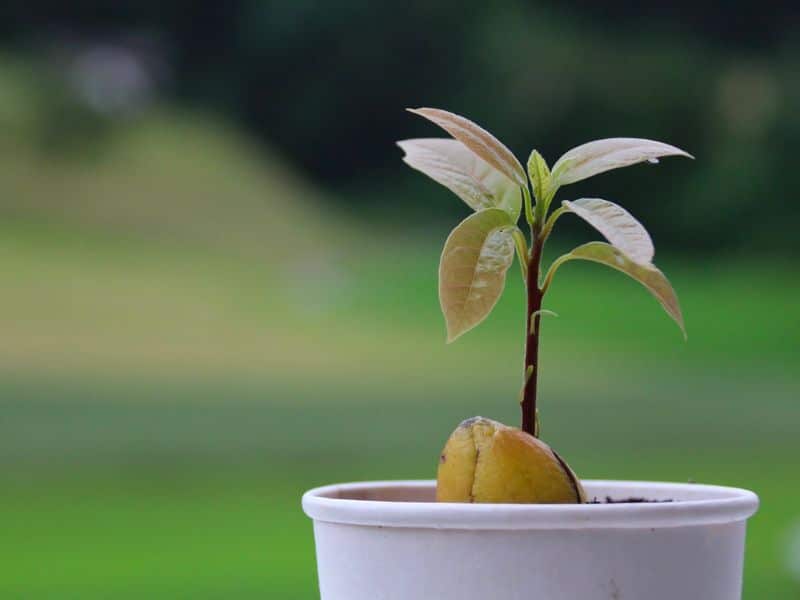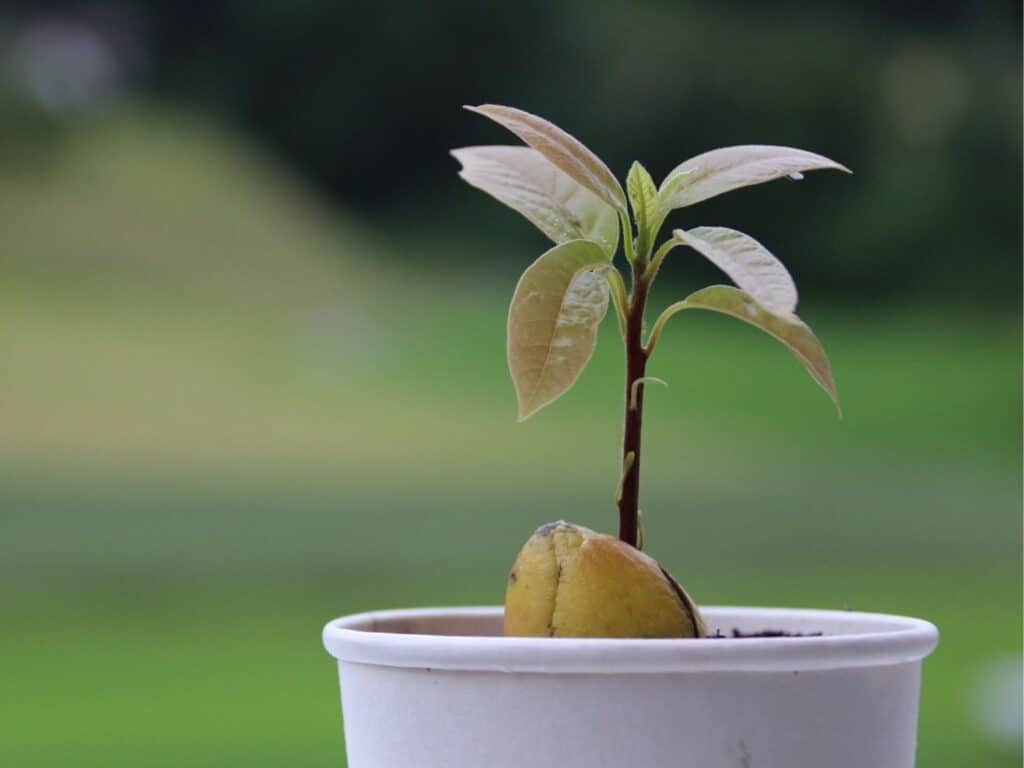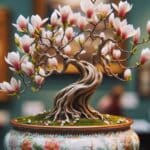Growing an avocado bonsai (Persea Americana) can be a fun experience. These interesting alligator pears can look charming with their bright foliage, and, if you are lucky, your small tree might even produce a small fruit or two to enjoy.
Growing an avocado plant is relatively easy, but keeping it small can be difficult. In this guide, we will show you how to grow an avocado bonsai and take good care of this type of tropical bonsai.

Plant Facts
| Scientific name | Persea americana |
| Common names | Avocado, Alligator pear |
| Family | Laurels |
| Plant Type | Fruit tree |
| Height and Width | 15-40 ft. tall (natural), 1–2 ft. tall (bonsai form) |
| Origin | Mexico |
| Flower colors | Small greenish |
| Foliage color | Light to dark green |
| Sun Exposure | 6 – 8 Hours of direct sun |
| Soil Type & pH | Well-drained, loose, loamy, or sandy soil with a neutral to slightly acidic pH |
| Special features | Fruit-bearing tree, low maintenance, suitable for container planting |
Can You Bonsai an Avocado?
You can bonsai an avocado tree, and the process is easy since these trees are so simple to grow and care for. However, there are better tree species to turn into a bonsai.
Avocado trees have huge leaves of about 4 – 12 inches, which is pretty big for a mini tree. These trees will also eventually outgrow their containers because they thrive and are relatively large by nature.
What Does an Avocado Bonsai Tree Look Like?

Bonsai avocado trees might not look as miniaturized as other species but they can still look quite adorable. Most bonsai artists will attempt to keep the seed at the base of their little tree for as long as possible because the chunky seed can add a lot of interest to your container.
Most bonsai avocados are relatively young plants with a green, slightly woody stem that can be trained or manipulated in just about any shape. Their leaves are almost the same size as that of a natural avocado.
Where Do Avocado Bonsai Trees Grow?
Avocados originate from Mexico but are widely grown in warm climates across the globe. The avocado plant flourishes in warm, subtropical regions with a higher humidity level.
Bonsai avocado trees are suitable as indoor trees but will grow well outside. It is usually best to keep this indoor tree outside during the warmer months and move it indoors when it gets too cold or too warm.
How to Grow Avocado Bonsai Trees
It is easy to grow an avocado tree but maintaining or maintaining or maintaining it miniaturized can be challenging. Let’s look at some of the best techniques for growing these trees and keeping them small.
Propagation
The best way to grow avocado bonsai trees is by growing them from seed. These trees can also be propagated from cuttings, grafting, or layering. Grafting is the most common option for commercial cultivation and isn’t too practical when you are growing a bonsai. Let’s explore some of the best propagation methods for an avocado bonsai.
Growing From seed
Because avocados become so big so fast, it is usually best to start with seedling trees. These trees are very easy to grow. You only need a healthy avocado seed, four toothpicks, and a mason jar.
Avocado seeds might be a bit tricky to find in stores. It is easier to buy a ripe avocado fruit and use the pit inside to grow your tree. The seed might have started germinating if the avocado is nice and ripe. Here is how to germinate an avocado seed.
- Extract the seed from the fruit without damaging it. Wash and dry the pit.
- Fill your mason jar with water.
- Push the toothpicks into the pit so these toothpicks can keep them from falling into your glass container.
- Hang the seed over the water container so the bottom of the pit lightly touches the water.
- You can now place the jar in a warm area with indirect light and replenish the water as needed.
- Within just a few weeks, you should see the seed germinate and sprout a healthy shoot out of the top of the pit and roots from the bottom of the pit.
- When the seedling is strong and healthy, it can be planted in a container or bonsai pot.
Growing From Cuttings
To propagate your avocado from cuttings, you will first need to take a cutting from an existing tree. It is best to do this during early spring. Here are some easy steps for growing an avocado from a cutting.
- Choose a new shoot with leaves that haven’t fully opened up yet. The cutting should be 5 – 6 inches long and you should cut it at an angle.
- Remove all the leaves from the bottom of the stem and only leave a few leaves at the top.
- Dip the cutting in root hormone powder to encourage quick growth.
- Plant the cutting in a pot with peat moss and perlite.
- Water the cutting and keep it in a humid and warm area until it starts to sprout some new growth.
Soil
Your avocado tree should be planted in well-draining soil or it will quickly develop root rot. An avocado bonsai tree will grow well in an average bonsai soil mixture. You can also create bonsai soil by mixing pumice, lava rock, Akadama, grit, and organic potting compost.
Avocados are tropical plants, which means they like soil with lots of nutrients and well-aerated moisture. You can use a ratio of 40% Akadama, 33.3% Pumice, and 30% Organic materials for a suitable soil mix. The gravel can be placed at the base of the bonsai pot so the soil will drain well.
Pruning and Training
Regular pruning is required to keep your avocado tree small and beautiful. This tree must also be wired with copper or aluminum wire to achieve the desired shape. It is best to prune the tree in early spring when it grows healthy and vigorously.
Avocados like to form a tall single stem. This main branch should be topped off early to keep your tree small and encourage branching. You can do this with a sharp pair of scissors when the shoot is about 30 cm tall.
Next, you must wait for the shoot to start growing branches.
Any unwanted branches can be trimmed off. The branches you want to keep and the main stem of the plant can be wrapped in bonsai wire so you can shape these branches into a more interesting bonsai form.
Avocado trees are evergreen and will stay full of leaves throughout the year. You can maintain its shape and growth throughout the year by lightly pruning any dead, damaged, or diseased leaves or branches. Branches that grow too tall can be clipped short and overly large leaves can be removed.
If your avocado bonsai tree is already trained or shaped, you can also hard prune it. Bonsai artists often defoliate the tree to eliminate overly large leaves and encourage some smaller leaf growth.
You can remove most or all branches just before the new growing season begins to defoliate the tree. When the tree sprouts new leaves, your bonsai avocado will look young and fresh with plenty of vibrant green leaves.
Repotting and Transplanting
Spring is the best time to repot an avocado bonsai. It would help if you planted the bonsai in a small pot because restricting its root growth will help keep it small for longer. The pot should have plenty of drainage holes and be bigger than the root system.
The avocado tree should be repotted yearly, and its root system should be trimmed every time you repot it. Here are the steps for repotting the small tree.
- Prepare the bonsai pot by creating a drainage layer with some gravel to prevent waterlogging.
- Remove the avocado bonsai tree from the old container and use a root rake to carefully clear away the old soil.
- Remove any diseased or damaged roots and trim back one-third of the plant’s root system.
- Next, you can add a layer of soil into the container, add the little tree, and fill the pot with bonsai soil. Be careful to remove all air bubbles around the roots.
- Keep the newly planted tree moist for a week or two so it can recover.
How to Care for an Avocado Bonsai Tree

Avocado trees are very easy to care for. They are ideal for bonsai beginners because these tres only need a little maintenance. Let’s look at how to care for these tiny trees properly.
Water
These tropical trees don’t like waterlogged conditions but still drink a lot of water and should be watered regularly. it is best to water the plant 2 – 3 times a week whenever the topsoil becomes dry. Watering can be reduced during winter.
Sunlight
Avocados can make good indoor trees but they need about 6 – 8 hours of direct sunlight per day. To accommodate the tree, you can position it in a sunny window or place it in your garden in a sunny spot.
Temperature and Humidity
These tropical trees grow best at temperatures between 60 and 85 degrees F. They can tolerate temperatures of as low as 28 degrees F but should be protected and brought indoors if it gets colder because the frost can damage the soft branches. On scorching days, you can also move the little plant to a more shaded area.
The trees love moderate humidity levels. In outdoor environments, they should be just fine, but if you are keeping the tree indoors, it is best to position it in a humidity tray.
Fertilizer
Avocado plants require lots of nutrients to stay healthy. You can offer the tree liquid fertilizer once a week when you water your tree. These types of fertilizers contain lots of nitrogen that can boost the growth of the tree as well as microorganisms that can enhance its ability to absorb nutrients.
There is no need to fertilize the tree during the winter months because it doesn’t grow much during this time.
Pest and Diseases
There are a couple of pests and diseases that you should keep an eye out for if you want to keep this small plant healthy and strong. Here is a quick look at some of the most common pests and diseases that these plants might struggle with.
Canker Disease
Canker disease can result from too much nitrogen in the soil or your tree can obtain this condition if the cuttings don’t heal well. If the tree becomes sick, you will notice lots of pale leaves, the trunk can swell up and the tree won’t grow well.
To treat canker disease, you should trim away affected branches and leaves, treat the tree with a fungicide, balance its nitrogen levels, and get rid of any dead wood around the base of the tree.
Chlorosis
Bonsai trees can get chlorosis if it has a mineral deficiency. To treat this condition, you will need to add more magnesium or iron to your soil mix.
Mildew
Fungal diseases like powdery mildew can start to grow on the leaves and stem of the tree if the humidity levels around the tree are too high or if air cannot circulate around the tree. This pesky fungus can be treated by spraying a mixture of baking soda, liquid soap, and water on the affected area. You can also move the tree to an area with better ventilation.
Sap Seeping Pests
Bonsai trees can be vulnerable to sap-seeping pests like aphids, mealybugs, or scales. These pests should be treated with a pesticide or horticultural oil to kill off the infestation.
Common Varieties and Cultivars
There are over 900 varieties of avocado trees and they can differ in size, texture, and shape and the fruits can be different sizes for these different varieties. For bonsai creations, it is usually best to focus on a smaller tree variety like the following;
- Hass Avocado
- Lamb Hass Avocado
- Wurtz or Little Cado Avocado
Conclusion
Avocado trees are not the best specimens for bonsai creations but it is entirely possible to create a bonsai from this plant species. With careful pruning, proper training, and good soil, you can successfully grow a miniature tree that might even bear a fruit or two that you can enjoy.
We hope that you enjoyed this guide and that you will have lots of fun experimenting with and growing your very own avocado bonsai.
Up next:







